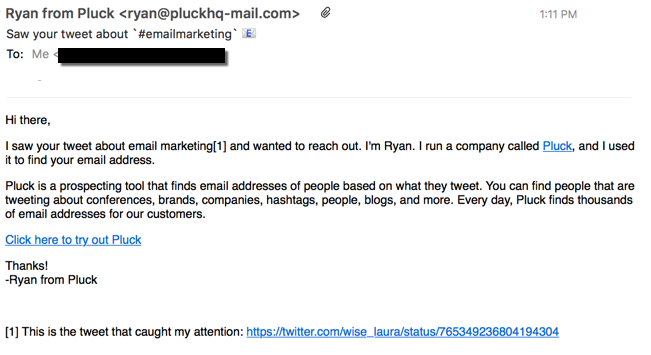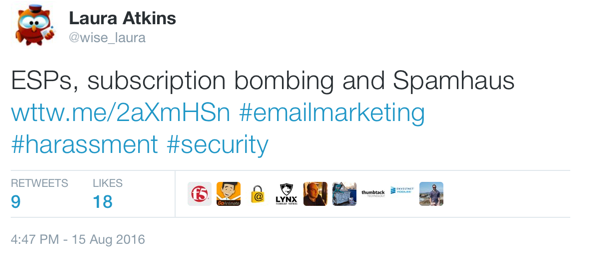Recent Posts
Ask Laura: Should we confirm unsubscribes?
- laura
- Dec 9, 2016
Dear Laura,
We have some questions about best practices for unsubscribes. Our ESP uses the List-Unsubscribe header by default on every email. I’m not familiar with this, and I have some questions for you.
First, do you think this is a good idea? Should we always use it, or just for certain emails? Should we use the mailto:link or link to a web site to unsubscribe?
We were also asked about double opt-out and if we should do it. We’re thinking that if someone clicks on the unsubscribe link they would be directed to a site displaying a message such as “Sorry to see you go. We have sent an email out for you to fully unsubscribe from the mailing list”. They then have to open the email and click on the link. Do you recommend doing this? Are there anti-spam regulations that this might violate?
And then, once someone unsubscribes (either with double opt-out or not), should we send out some sort of email confirmation? We currently do not, but we’re thinking of sending something like “Sorry to see you go. If you unsubscribed accidentally please click here to re-subscribe.” What do you think?
Thanks,
Breaking Up Is Hard to Do
Industry news
- laura
- Dec 7, 2016
Just some stuff going on around email that probably merit a mention but not a whole blog post.
Next Tuesday at 1 eastern I’ll be giving a webinar on the subscription bombing and discussing what companies can do to mitigate the problem.
Google is working on new “invisible” captchas, that separate out humans from bots without humans having to do anything.
EmailonAcid created an interactive puzzle email.
Return Path acquired Email Copilot. Then laid off approximately 60 employees citing restructuring (no links for this one, but emails were sent to customers and someone forwarded me a copy).
Mailchimp sent 1.5 billion emails on Black Friday, and published stats and information about how well they delivered and performed.
Outreach or spam?
- laura
- Dec 6, 2016
This showed up in my mailbox earlier today:
The tweet in question
From Crunchbase: “Pluck is an email prospecting tool that gives you the email addresses of the people tweeting about subjects related to your business.”
Prospecting: another name for spamming. Look, I know that you want to sell you’re newest, greatest product to the world. But just because I tweet something with a # that you think is relevant to your product doesn’t mean that I want to get your spam. I also know it’s hard to get attention and find prospects; I’m a small business owner, too and I need to market my own services. But spamming isn’t a good idea. Ever.
There’s been a significant increase in this kind of spam “to help your business” lately. It’s a rare day I don’t get something from some company I’ve never heard of trying to sell me their newest product. It might be something if they tried a contact or two and then went away. But they’ll send mail for weeks or months without getting an answer. Look, silence IS an answer and it means you need to go away and leave your prospects alone.
Unfortunately, there are services out there that sell a product that let you “automatically follow up” with your prospects. Pluck up there uses one of them, as that’s who’s handling all the links in the message. In fact, if you go to the bare domain (qcml.io) they talk a good anti-spam game. “Die, spammers, die.” I reported the message to them. I’m not expecting them to actually do anything, and I’m not expecting a response.
It’s just spam under another name. There’s no pretense that it’s anything else. Even if it’s sent in a way that makes it look like a real person typed the message, like QuickMail offers. “All emails will come straight out of your personal inbox as though you typed them yourself.” As if you typed them yourself.
The worst part is there’s no real way to stop the mail. I can’t unsubscribe. The companies selling the software don’t provide any guidance to their customers about what the law requires. Take the message from Pluck that started the post. It violates CAN SPAM in multiple ways. Moreover, the address they used is not publicly associated with my twitter handle, which means they’re doing some harvesting somewhere. That means treble penalties under CAN SPAM.
I could reply and ask them to stop mailing me. I’ve done that a couple times with a message that says, “Please don’t email me any more.” I’ve got to tell you, some people get really mad when you ask them not to email you. Some just say yes, but others are really offended that you asked them to stop and get abusive. It’s gotten to the point where I don’t ask any more because of that one person who decides to harass, threaten and scream at me. Sure, it’s maybe 1 in 5, but I don’t have the time or energy to figure out who is going to be receptive and who isn’t. I don’t have time for that. No one has time for that.
I’m expecting that filters are going to catch up eventually and these types of mail will be easier to filter out. Until then, though, small business owners like myself are stuck in a place where we have to deal with spam distracting us from our business. At least I get blog content out of it.
November 2016: The Month In Email
- laura
- Dec 2, 2016
Happy December! Between #blackfriday, #cybermonday & #givingtuesday, pretty much everyone in the US has just survived a week of email from every brand and organization they’ve ever interacted with. Phew.
Is this still the best strategy for most senders? Maybe. But it’s always important to be adaptable and continue to evaluate and evolve your strategy as you move through the year.
As always, I continue to think about evolving our own strategies, and how we might best support senders and ESPs. One of the challenges we face when we talk to senders with deliverability questions is that so many of our answers fall into a nebulous “it depends” zone. We’re trying to articulate new ways to explain that to people, and to help them understand that the choices and details they specify at each point of their strategic planning and tactical execution have ramifications on their delivery. While “it depends” is still a correct answer, I’m going to try to avoid it going forward, and instead focus on exploring those choices and details with senders to help them improve deliverability.
In our community of deliverability and anti-abuse professionals, we are — as you’d expect — quite sensitive to unsolicited email that targets our industry. When an email circulates, even what seems like a reasonably well-thought-out email, it occasionally does not land well. Worse still are the various email-related product and service providers who try to legitimize B2B sales messaging as if it is something other than spam.
The takeaway from these discussions for senders is, as always: know your audience. This post about research from Litmus on millennials and spam is a great example of the kinds of things you might consider as you get to know your audience and how they prefer to communicate.
We also had a presidential election this month, one that made much of issues related to email, and it will be interesting to see how the candidates and parties use the email data they collected going forward.
In industry and security news, we saw over a million Google accounts breached by Android malware. We also saw some of the ramifications of a wildcard DNS entry from a domain name expiration — it’s an interesting “how things work” post if you’re curious. In other “how things work” news, we noted some of the recent changes AOL made to its FBL.
I answered an Ask Laura question about dedicated IP pools, and I have a few more queued up as well. As always, we want to know what questions are on the minds of our readers, so please feel free to send them over!
Google accounts breached
- laura
- Dec 1, 2016
Over 1 million Google accounts breached by Android malware.
There are some folks I know who really can’t understand why I stick with Apple over Android. The above issue is a big one. Doing what we do, security is a major consideration. I don’t need my accounts, or other accounts I have access to, compromised. It’s not that Apple is 100% compromise proof, but there are more checks and balances in the pipeline.
On the deliverability front, I had a recent interaction with someone from iCloud. This is a colleague I’ve worked with for years now, following him through multiple job changes. A client was having some delivery issues with a shared IP, so I was asking if he could send me some data to help track down the problem customer. I have a habit of asking for subject lines when I’m trying to get data. It’s usually enough for an ESP to track down the problem, and they’re not a way for folks to track down spamtraps or recipients. The answer I got back was sorry, they couldn’t give me any information at all, even something minor like a subject line.
Apple takes user privacy seriously and are doing a lot to protect their users. Does that mean I spend too much money on hardware I could buy cheaper? Perhaps. But, I’ll pay a little more to work with a company that puts privacy at the center of their product suite.
Oracle buys Dyn
- laura
- Nov 30, 2016
Last week Oracle announced they were buying Dyn. Interesting acquisition, but fills a spot in Oracle’s playbook to provide infrastructure.
None of the press releases I’ve seen about the acquisition mentions the Dyn email service platform. Oracle has at least two email platforms already (Eloqua and Responsys). It will be interesting to see what happens with email.
DNSBLs, wildcards and domain expiration
- laura
- Nov 29, 2016
Last week the megarbl.net domain name expired. Normally this would have no affect on anyone, but their domain registrar put in a wildcard DNS entry. Because of how DNSBLs work, this had the effect of causing every IP to be listed on the blocklist. The domain is now active and the listings due to the DNS wildcard are removed.
Read MoreDon't forget the strategy
- laura
- Nov 23, 2016
We’re two days out from the beginning of the Holiday Shopping Season here in the US. Three days out from one of the biggest retail shopping days of the year in the US. 5 days out from one of the biggest online shopping days of the year.
I’m sure everyone has their mail campaigns planned. Most of the messages are finished, just waiting for a tweak or the exact right image.
The challenge, during this time of year, is to actually think strategically about marketing. The challenge is to pay attention to what subscribers and ISPs are telling you. The challenge is to adapt to conditions on the ground, rather than just executing a strategy planned months ago.
I often joke that my job gets quiet around this time of the year. Most of my clients and customers are busy executing their strategy, not planning it. So much mail is being slung around that no one really has time to do any thinking about it. That is, of course, a gross exaggeration, smart email marketers are always considering strategy even as they’re in the middle of the holiday mailing season. They still pay attention, they adapt to the conditions, they get the mail through.
Just remember, 2016 is almost over. But we still have a lot of email to send first.
It depends… no more
- laura
- Nov 22, 2016
The two most hated words in deliverability. Many people ask general questions about deliverability and most experts, including myself, answer, “It depends.”
There are a lot of problems with this answer. The biggest problem is that it’s led to the impression that there are no real answers about deliverability. That because we can’t answer hypothetical questions we are really just making the answers up.
The reason we use “it depends” is because the minute details matter when it comes to deliverability. Wether or not something will hurt or help deliverability depends on the specific implementation. Who’s doing the sending? What is their authentication setup? What IP are they using? How were the addresses collected? What is their frequency? What MTA is used? Are they linking to outside sites? Are they linking to outside services? Where are images hosted? The relevant questions go on and on and on.
I am going to stop saying it depends when answering generic deliverability questions. Instead I will be using the phrase “details matter.” Details do matter. Details are everything. Details drive deliverability.
Details Matter
The importance of details is why many deliverability people hedge their answers. The details do matter.
I will do my best to stop answering It Depends to deliverability questions. Instead, I’ll be answering with question and pointing out the details matter.
Recipients and the Spam Button
- laura
- Nov 18, 2016
Earlier this week Litmus and Fluent hosted a webinar title “Adapting to Consumers’ New Definition of Spam.” This had a number of fascinating facts about email marketing, many of which should reassure folks. Litmus has a blog post up highlighting some of the findings specific to millennials and email. Good news is millennials like getting mail from brands and interact with them regularly. Even better, they will rescue mail out of the spam folder.
Litmus has a blog post up highlighting some of the findings specific to millennials and email. Good news is millennials like getting mail from brands and interact with them regularly. Even better, they will rescue mail out of the spam folder.
The full whitepaper is available from Fluent: 2016 Consumer Perceptions of Email. I’ll be writing more about this over the interesting tidbits here over the next few weeks. But I really suggest people go download it and read it.
Categories
Tags
- 2010
- 2016
- 2fa
- 419
- 4xx
- 554
- 5xx
- @
- Aarp
- Abacus
- Abandoned
- Aboutmyemail
- Abuse
- Abuse Desk
- Abuse Enforcement
- Abuse Prevention
- Academia
- Accreditation
- Acme
- Acquisition
- Address Book
- Addresses
- Administrivia
- Adsp
- Advanced Delivery
- Advertiser
- Advertising
- Advice
- Affiliate
- Affiliates
- After the Email
- Alerts
- Algorithm
- Alice
- Alignment
- Allcaps
- Alt Text
- AMA
- Amazon
- Amp
- Amsterdam
- Analysis
- Anecdotes
- Anti-Spam
- Anti-Spam Laws
- Anti-Spammers
- Antwort
- AOL
- Appeals
- Appearances
- Appending
- Apple
- Arc
- Arf
- Arrest
- Arrests
- Ascii
- Asides
- Ask Laura
- Askwttw
- Assertion
- Assumptions
- ATT
- Attacks
- Attention
- Attrition
- Audit
- Authentication
- Authentication. BT
- Autonomous
- Award
- B2B
- B2C
- Backhoe
- Backscatter
- Backus-Naur Form
- Banks
- Barracuda
- Barry
- Base64
- Base85
- Bcp
- Bear
- Bears
- Behaviour
- Benchmark
- BESS
- Best Practices
- Bgp
- Bimi
- Bit Rot
- Bitly
- Bizanga
- Black Friday
- Blackfriday
- Blacklist
- Blacklists
- Blast
- Blo
- Block
- Blockin
- Blocking
- Blocklist
- Blocklisting
- Blocklists
- Blocks
- Blog
- Blog Links
- Blogroll
- Blogs
- Bob
- Boca
- Bofa
- Book Review
- Bot
- Botnet
- Botnets
- Bots
- Bounce
- Bounce Handling
- Bounces
- Branding
- Brands
- Breach
- Breaches
- Breech
- Bronto
- Browser
- Bsi
- Bucket
- Bulk
- Bulk Folder
- Bulk Mail
- Business
- Business Filters
- Buying Leads
- Buying Lists
- C-28
- CA
- Caa
- Cabbage
- Cache
- Cadence
- CAH
- California
- Campaign
- CAN SPAM
- Canada
- Candy
- Candycandycandy
- Canonicalization
- Canspam
- Captcha
- Career Developmnent
- Careers at WttW
- Cargo Cult
- Case Law
- Cases
- CASL
- Cat
- Cbl
- CDA
- Cert
- Certification
- CFL
- Change
- Charter
- Cheat
- Cheese
- Choicepoint
- Choochoo
- Christmas
- Chrome
- Cidr
- Cisco
- Civil
- Clear.net
- Clearwire.net
- Cli
- Click
- Click Through
- Click Tracking
- Clicks
- Clickthrough
- Client
- Cloudflare
- Cloudmark
- Cname
- Co-Reg
- Co-Registration
- Cocktail
- Code
- COI
- Comcast
- Comments
- Commercial
- Communication
- Community
- Comodo
- Comparison
- Competitor
- Complaint
- Complaint Rates
- Complaints
- Compliancce
- Compliance
- Compromise
- Conference
- Conferences
- Confirmation
- Confirmed (Double) Opt-In
- Confirmed Opt-In
- Congress
- Consent
- Conservatives
- Consistency
- Constant Contact
- Consultants
- Consulting
- Content
- Content Filters
- Contracts
- Cookie
- Cookie Monster
- COPL
- Corporate
- Cost
- Court Ruling
- Cox
- Cox.net
- Cpanel
- Crib
- Crime
- CRM
- Crowdsource
- Crtc
- Cryptography
- CS&M
- CSRIC
- CSS
- Curl
- Customer
- Cyber Monday
- Czar
- Data
- Data Hygiene
- Data Security
- Data Segmentation
- Data Verification
- DBL
- Dbp
- Ddos
- Dea
- Dead Addresses
- Dedicated
- Dedicated IPs
- Defamation
- Deferral
- Definitions
- Delays
- Delisting
- Deliverability
- Deliverability Experts
- Deliverability Improvement
- Deliverability Summit
- Deliverability Week
- Deliverability Week 2024
- Deliverabiltiy
- DeliverabiltyWeek
- Delivery Blog Carnival
- Delivery Discussion
- Delivery Emergency
- Delivery Experts
- Delivery Improvement
- Delivery Lore
- Delivery News
- Delivery Problems
- Dell
- Design
- Desks
- Dhs
- Diagnosis
- Diff
- Dig
- Direct Mag
- Direct Mail
- Directives
- Discounts
- Discovery
- Discussion Question
- Disposable
- Dk
- DKIM
- Dkimcore
- DMA
- Dmarc
- DNS
- Dnsbl
- Dnssec
- Docs
- Doingitright
- Domain
- Domain Keys
- Domain Reputation
- DomainKeys
- Domains
- Domains by Proxy
- Dontpanic
- Dot Stuffing
- Dotcom
- Double Opt-In
- Dublin
- Dyn
- Dynamic Email
- E360
- Earthlink
- Ec2
- Ecoa
- Economics
- ECPA
- Edatasource
- Edns0
- Eec
- Efail
- Efax
- Eff
- Election
- Email Address
- Email Addresses
- Email Change of Address
- Email Client
- Email Design
- Email Formats
- Email Marketing
- Email Verification
- Emailappenders
- Emailgeeks
- Emails
- Emailstuff
- Emoji
- Emoticon
- Encert
- Encryption
- End User
- Endusers
- Enforcement
- Engagement
- Enhanced Status Code
- Ennui
- Entrust
- Eol
- EOP
- Epsilon
- Esp
- ESPC
- ESPs
- EU
- Ev Ssl
- Evaluating
- Events
- EWL
- Exchange
- Excite
- Expectations
- Experience
- Expires
- Expiring
- False Positives
- FAQ
- Fathers Day
- Fbl
- FBL Microsoft
- FBLs
- Fbox
- FCC
- Fcrdns
- Featured
- Fedex
- Feds
- Feedback
- Feedback Loop
- Feedback Loops
- Fiction
- Filter
- Filter Evasion
- Filtering
- Filterings
- Filters
- Fingerprinting
- Firefox3
- First Amendment
- FISA
- Flag Day
- Forensics
- Format
- Formatting
- Forms
- Forwarding
- Fraud
- Freddy
- Frequency
- Friday
- Friday Spam
- Friendly From
- From
- From Address
- FTC
- Fussp
- Gabbard
- GDPR
- Geoip
- Gevalia
- Gfi
- Git
- Giveaway
- Giving Up
- Global Delivery
- Glossary
- Glyph
- Gmail
- Gmails
- Go
- Godaddy
- Godzilla
- Good Email Practices
- Good Emails in the Wild
- Goodmail
- Google Buzz
- Google Postmaster Tools
- Graphic
- GreenArrow
- Greylisting
- Greymail
- Groupon
- GT&U
- Guarantee
- Guest Post
- Guide
- Habeas
- Hack
- Hacking
- Hacks
- Hall of Shame
- Harassment
- Hard Bounce
- Harvesting
- Harvey
- Hash
- Hashbusters
- Headers
- Heartbleed
- Hearts
- HELO
- Help
- Henet
- Highspeedinternet
- Hijack
- History
- Holiday
- Holidays
- Holomaxx
- Hostdns4u
- Hostile
- Hostname
- Hotmail
- How To
- Howto
- Hrc
- Hsts
- HTML
- HTML Email
- Http
- Huey
- Humanity
- Humor
- Humour
- Hygiene
- Hypertouch
- I18n
- ICANN
- Icloud
- IContact
- Identity
- Idiots
- Idn
- Ietf
- Image Blocking
- Images
- Imap
- Inbox
- Inbox Delivery
- Inboxing
- Index
- India
- Indiegogo
- Industry
- Infection
- Infographic
- Information
- Inky
- Inline
- Innovation
- Insight2015
- Integration
- Internationalization
- Internet
- Intuit
- IP
- IP Address
- Ip Addresses
- IP Repuation
- IP Reputation
- IPhone
- IPO
- Ipv4
- Ipv6
- Ironport
- Ironport Cisco
- ISIPP
- ISP
- ISPs
- J.D. Falk Award
- Jail
- Jaynes
- JD
- Jobs
- Json
- Junk
- Juno/Netzero/UOL
- Key Rotation
- Keybase
- Keynote
- Kickstarter
- Kraft
- Laposte
- Lavabit
- Law
- Laws
- Lawsuit
- Lawsuits
- Lawyer
- Layout
- Lead Gen
- Leak
- Leaking
- Leaks
- Legal
- Legality
- Legitimate Email Marketer
- Letsencrypt
- Letstalk
- Linked In
- Links
- List Hygiene
- List Management
- List Purchases
- List the World
- List Usage
- List-Unsubscribe
- Listing
- Listmus
- Lists
- Litmus
- Live
- Livingsocial
- London
- Lookup
- Lorem Ipsum
- Lycos
- Lyris
- M3AAWG
- Maawg
- MAAWG2007
- Maawg2008
- MAAWG2012
- MAAWGSF
- Machine Learning
- Magill
- Magilla
- Mail Chimp
- Mail Client
- MAIL FROM
- Mail Privacy Protection
- Mail Problems
- Mail.app
- Mail.ru
- Mailboxes
- Mailchimp
- Mailgun
- Mailing Lists
- Mailman
- Mailop
- Mainsleaze
- Maitai
- Malicious
- Malicious Mail
- Malware
- Mandrill
- Maps
- Marketer
- Marketers
- Marketing
- Marketo
- Markters
- Maths
- Mcafee
- Mccain
- Me@privacy.net
- Measurements
- Media
- Meh
- Meltdown
- Meme
- Mentor
- Merry
- Message-ID
- Messagelabs
- MessageSystems
- Meta
- Metric
- Metrics
- Micdrop
- Microsoft
- Milter
- Mime
- Minimal
- Minshare
- Minute
- Mit
- Mitm
- Mobile
- Models
- Monitoring
- Monkey
- Monthly Review
- Mpp
- MSN/Hotmail
- MSN/Hotmail
- MTA
- Mua
- Mutt
- Mx
- Myths
- Myvzw
- Needs Work
- Netcat
- Netsol
- Netsuite
- Network
- Networking
- New Year
- News
- News Articles
- Nhi
- NJABL
- Now Hiring
- NTP
- Nxdomain
- Oath
- Obituary
- Office 365
- Office365
- One-Click
- Only Influencers
- Oops
- Opaque Cookie
- Open
- Open Detection
- Open Rate
- Open Rates
- Open Relay
- Open Tracking
- Opendkim
- Opens
- Openssl
- Opt-In
- Opt-Out
- Optonline
- Oracle
- Outage
- Outages
- Outblaze
- Outlook
- Outlook.com
- Outrage
- Outreach
- Outsource
- Ownership
- Owning the Channel
- P=reject
- Pacer
- Pander
- Panel
- Password
- Patent
- Paypal
- PBL
- Penkava
- Permission
- Personalities
- Personalization
- Personalized
- Pgp
- Phi
- Philosophy
- Phish
- Phishers
- Phishing
- Phising
- Photos
- Pii
- PIPA
- PivotalVeracity
- Pix
- Pluscachange
- Podcast
- Policies
- Policy
- Political Mail
- Political Spam
- Politics
- Porn
- Port25 Blocking
- Postfix
- Postmaster
- Power MTA
- Practices
- Predictions
- Preferences
- Prefetch
- Preview
- Primers
- Privacy
- Privacy Policy
- Privacy Protection
- Private Relay
- Productive Mail
- Promotions
- Promotions Tab
- Proofpoint
- Prospect
- Prospecting
- Protocols
- Proxy
- Psa
- PTR
- Public Suffix List
- Purchased
- Purchased Lists
- Purchases
- Purchasing Lists
- Questions
- Quoted Printable
- Rakuten
- Ralsky
- Rant
- Rate Limiting
- Ray Tomlinson
- Rc4
- RDNS
- Read
- Ready to Post
- Readytopost
- Real People
- Realtime Address Verification
- Recaptcha
- Received
- Receivers
- Recipient
- Recipients
- Redirect
- Redsnapper
- Reference
- Registrar
- Registration
- Rejection
- Rejections
- Rejective
- Relationship
- Relevance
- Relevancy
- Removals
- Render Rate
- Rendering
- Repost
- Repudiation
- Reputation
- Requirements
- Research
- Resources
- Responsive
- Responsive Design
- Responsys
- Retail
- Retired Domains
- Retro
- Return Path
- Return Path Certified
- ReturnPath
- Reunion.com
- Reverse Dns
- RFC
- RFC2047
- RFC2821/2822
- RFC5321/5322
- RFC5322
- RFC8058
- RFC821/822
- RFCs
- Roadr
- RoadRunner
- Rodney Joffe
- ROKSO
- Role Accounts
- Rollout
- RPost
- RPZ
- Rule 34
- Rules
- Rum
- Rustock
- S.1618
- SaaS
- Sales
- Salesforce
- Sass
- SBCGlobal
- Sbl
- Scam
- Scammers
- Scams
- Scanning
- Scraping
- Screamer
- Screening
- Script
- Sec
- Secure
- Security
- Segmentation
- Selligent
- Send
- Sender
- Sender Score
- Sender Score Certified
- Senderbase
- Senderid
- Senders
- Senderscore
- Sendgrid
- Sending
- Sendy
- Seo
- Service
- Services
- Ses
- Seth Godin
- SFDC
- SFMAAWG2009
- SFMAAWG2010
- SFMAAWG2014
- Shared
- Shell
- Shouting
- Shovel
- Signing
- Signups
- Silly
- Single Opt-In
- Slack
- Slicing
- Smarthost
- Smiley
- Smime
- SMS
- SMTP
- Snds
- Snowshoe
- Soa
- Socia
- Social Media
- Social Networking
- Soft Bounce
- Software
- Sony
- SOPA
- Sorbs
- Spam
- Spam Blocking
- Spam Definition
- Spam Filtering
- Spam Filters
- Spam Folder
- Spam Law
- Spam Laws
- Spam Reports
- Spam Traps
- Spam. IMessage
- Spamarrest
- Spamassassin
- Spamblocking
- Spamcannibal
- Spamcon
- Spamcop
- Spamfiltering
- Spamfilters
- Spamfolder
- Spamhaus
- Spamhause
- Spammer
- Spammers
- Spammest
- Spamming
- Spamneverstops
- Spamresource
- Spamtrap
- Spamtraps
- Spamza
- Sparkpost
- Speaking
- Special Offers
- Spectre
- SPF
- Spoofing
- SproutDNS
- Ssl
- Standards
- Stanford
- Starttls
- Startup
- State Spam Laws
- Statistics
- Storm
- Strategy
- Stunt
- Subject
- Subject Lines
- Subscribe
- Subscriber
- Subscribers
- Subscription
- Subscription Process
- Success Stories
- Suing
- Suppression
- Surbl
- Sureclick
- Suretymail
- Survey
- Swaks
- Syle
- Symantec
- Tabbed Inbox
- Tabs
- Tagged
- Tagging
- Target
- Targeting
- Techincal
- Technical
- Telnet
- Template
- Tempo
- Temporary
- Temporary Failures
- Terminology
- Testing
- Text
- Thanks
- This Is Spam
- Throttling
- Time
- Timely
- TINS
- TLD
- Tlp
- TLS
- TMIE
- Tmobile
- Too Much Mail
- Tool
- Tools
- Toomuchemail
- Tor
- Trademark
- Traffic Light Protocol
- Tragedy of the Commons
- Transactional
- Transition
- Transparency
- Traps
- Travel
- Trend/MAPS
- Trend Micro
- Trend/MAPS
- Trigger
- Triggered
- Troubleshooting
- Trustedsource
- TWSD
- Txt
- Types of Email
- Typo
- Uce
- UCEprotect
- Unblocking
- Uncategorized
- Unexpected Email
- Unicode
- Unroll.me
- Unsolicited
- Unsubcribe
- Unsubscribe
- Unsubscribed
- Unsubscribes
- Unsubscribing
- Unsubscription
- Unwanted
- URIBL
- Url
- Url Shorteners
- Usenet
- User Education
- Utf8
- Valentine's Day
- Validation
- Validity
- Value
- Valueclick
- Verification
- Verizon
- Verizon Media
- VERP
- Verticalresponse
- Vetting
- Via
- Video
- Violence
- Virginia
- Virtumundo
- Virus
- Viruses
- Vmc
- Vocabulary
- Vodafone
- Volume
- Vzbv
- Wanted Mail
- Warmup
- Weasel
- Webinar
- Webmail
- Weekend Effect
- Welcome Emails
- White Space
- Whitelisting
- Whois
- Wiki
- Wildcard
- Wireless
- Wiretapping
- Wisewednesday
- Women of Email
- Woof
- Woot
- Wow
- Wtf
- Wttw in the Wild
- Xbl
- Xfinity
- Xkcd
- Yahoo
- Yahoogle
- Yogurt
- Zoidberg
- Zombie
- Zombies
- Zoominfo
- Zurb
